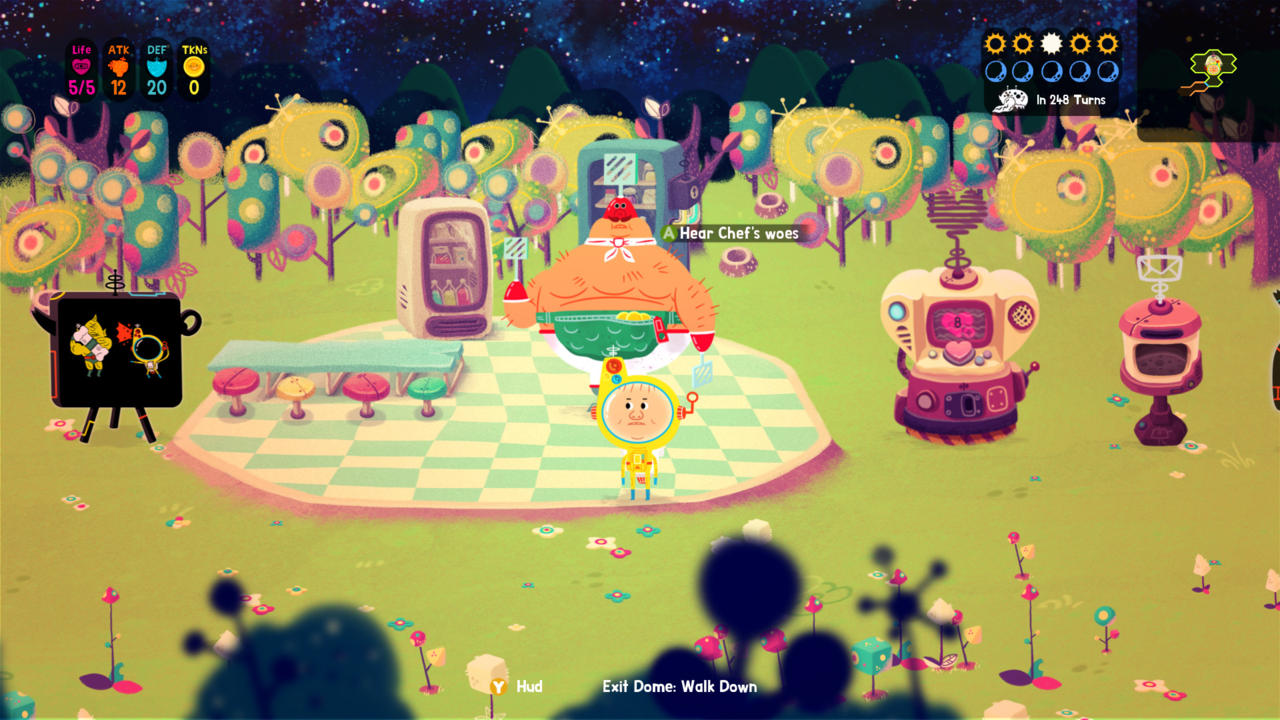The opening cutscene of Loot Rascals, largely narrated by a teapot-headed British spaceman, establishes the game’s strange tone well. Instead of arriving at a holiday-resort planet to restore a medical unit's antenna as intended, you crash on an alien moon and find yourself battling against the game’s eponymous “rascals” that have stolen the medical unit. To get it back, you’ll need to trek through five randomly generated levels, battling or avoiding the moon’s many aggressors.
Loot Rascals is wacky in a way that feels genuine; the art style and creature design in particular feel like the work of artists who watched a lot of The Ren & Stimpy Show as kids and soaked up its playful grotesquery.
The action in Loot Rascals unfolds in a turn-based fashion. You move between hexagonal spaces, uncovering each area as you go, and either fight or circumvent enemies you encounter. Your goal is to find the warp spaces in each zone and make it to the fifth level to escape. Your attack and defense ratings are determined by the cards you’ve collected from defeated enemies. Meanwhile, enemies toggle between attack and defense modes on a day-night cycle that sees the sun or moon rise every five turns. Battles are automatically triggered when you and an enemy are on the same space. You want to attack foes while they’re defending because you’ll score the first hit--and, if your attack rating is high enough, you’ll be able to take them out before they get their chance to counterattack.
It’s a solid core system, especially if you manage to get your hands on some strong cards early on. Several have different mutations that can strengthen your stats or grant new abilities. You can equip eight cards at once and hold six others, and where you place them in your “hand” matters--a card may power up all others to its right, for example, or lose all power if placed in the top row. Balancing your cards and figuring out the best combinations based on what you have is one of the game’s more rewarding elements.
Loot Rascals’ core problem is repetition. This is, admittedly, a core part of the roguelike experience, where if you're ever defeated in battle, you lose all of you progress and must start a new playthrough. But the best games in the genre find ways to keep the early stages interesting during repeated plays. While the levels themselves are randomly generated, each stage’s main enemies and features are largely the same each time. While being fastidious, checking your map as it reveals itself, and picking your battles are all important, there’s a strong element of luck to Loot Rascals that becomes grating after a while. A handful of truly powerful, useful cards can greatly increase your chances of progress, so if you don’t encounter any of them early on, the uphill battle you’re fighting can start to feel insurmountable.
Over hours of play, your success starts to feel arbitrary, and fighting your way through the first area over and over again feels rote and dull.
If you’re not loaded up with cards augmented with abilities--which allow you to hit enemies from a distance with attacks and distractions--progress can stagnate. Enemies have different movement patterns and abilities, but none of them truly shake up the gameplay. It’s rare that you’ll be in a position to use your environment to your advantage or employ tactics beyond attacking or running away. The lack of a story outside of the opening and closing cutscenes means that runs never feel like narrative adventures the way they do in some stronger roguelikes. You never die with a sense that something exciting just happened, or that tragedy struck--only a sense of annoyance at needing to start over.
The game does provide some help, at least: if you find a certain card in each area and return it to a character at your starting point you’ll unlock extra abilities, including a super helpful “reveal the full map” ability in the second area. However, if you don’t happen across the good cards while venturing around each map, it becomes very difficult to progress. Over hours of play, your success starts to feel arbitrary, and fighting your way through the first area over and over again feels rote and dull.

Loot Rascal's simplicity ends up weakening its prospects as a long-term time investment and it’s not the kind of game that leaves you feeling like you’ve learned much from your losses. The only progress that carries over between playthroughs depends on the kindness of other players: when you die, the enemy that kills you can snatch one of your cards, and if another player encounters that enemy in their game and vanquishes the foe, they can choose to return that card to you, lest their game be haunted by your vengeful ghost.
Loot Rascals card and deck systems are enticing, and its singular aesthetic and strange sense of humor make the game fundamentally likable early on. After a few hours, however, it feels like there isn't a lot to gain for all the effort you're asked to put in. There are fleeting moments of joy when a strategic card collection lets you steamroll through the enemy forces, but the monotony of getting to those moments wears you down in the end.









